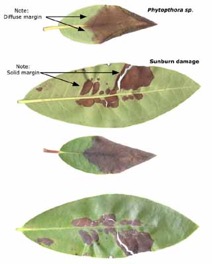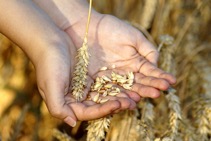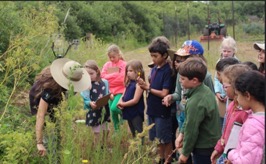|
Dear ,
Weeding. Getting those pesky weeds out of our beautiful parklands
seems like a never-ending task. Although, each year it gets better and our
understanding of best control practices improves. Let’s grab our picks and put
a dent in that seed bank!
For those who have joined us recently you may have recognized
a new face on our team! Please welcome our summer intern, Guan
In This Newsletter:
Phytophthora
By Camila Fishtahler

Phytophthora
ramorum
Photo Credit Matteo Garbelotto, UC Berkeley
|
Phytophthora:
φυτόν (phytón), φθορά (phthorá), for those of you not brushed up
on Greek, that translates to “plant-destroyer.” Phytophthora is a genus of
oomycetes (oomycota
are a fungus-like eukaryotic microorganisms) whose member species
are known to cause damage across natural ecosystems and crops worldwide. There
are about 150 species currently described but it is believed that there are
over 200 yet to be described Brasier, page 101.
One
of the reasons Phytophthora is a problem, not just in California but worldwide,
is that phytophthora is known for rapid adaptation and hybridization. However,
little is known about oomycete populations or the mechanisms behind their
ability to rapidly adapt. 5
Notorious Phytophthoras include P.
infestans, which causes potato late blight and caused the 1840s Irish
potato famine. 2 The Golden Gate National Parks are no stranger to Phytophthora—as most of our readers may be familiar with P. ramorum, otherwise
known as Sudden Oak Death (SOD).
|
Over 140 native and non-native plants are known to be hosts
Some of which include:
Coast Live Oak
Rhododendrons
Camellias
Toyon
California Honeysuckle
California coffeeberry
Wood Rose
Witch hazel
Manzanita
…
To see a list written up by the USDA, check out
this link
Here |
First recognized in the mid-1950s, P. ramorum has had devastating effects
on coastal forests in California and Oregon and is known to infect over 18
species of woody plants and other common horticultural plants though more
plants seem to be added to the list every now and then. 3 4
As an
invasive species, P. ramorum is
quarantined in over 60 countries and has resulted in a series of restrictions
enforced upon shipments of nursery stock and plant material. 3 In California, infestations are known
to be present in 15 counties including San Mateo, Marin, and San Francisco. 6
How did it get to California?
The first identification of P. ramorum was reported in 1995 in Mill Valley on tanoak.8
It spread into wildlands via infected nursery stock which is
believed to have originated from Marin and Santa Cruz, however its native
origin has yet to be discovered. 7
What does Phytophthora do?
Like most species of oomycetes, P. ramorum is described as a water mold.
It works by starting from the roots up through the root
crown and moves into the lower trunk where it starts to kill the inner bark. 14
As soon as the root is attacked the health of the plant
diminishes. By killing off the fine roots, P.
ramorum keeps the plant from uptaking enough water from the soil, and as a
result the plant starts undergoing chronic water stress. 14
The infected plant may appear healthy for up to
two years before it turns brown and suddenly dies. 10
How
is it spreading?
Water and moist conditions are important for the infection
process and life cycle, most phytophthora are terrestrial plant pathogens
(infecting land dwelling plants). 8
When phytophthora reproduces (may be both sexually or asexually) it produces
zoospores (swimming spores) which thrive under wet environmental conditions. 8
9
Under these wet, humid conditions the spores can be spread
through wind-drive, rain, runoff, movement of infected plant material,
contaminated soil and human activity. Some plants such as California bay laurel
trees, madrones, and rhododendrons contain large amounts of spores that can be
dispersed through the air. 10
11
The most probable way for the spread of spores is by humans
unintentionally moving contaminated soil along trails through their shoes and
car tires into other natural areas. 11
Nurseries sending out infected plants or growing plants in
contaminated soil was a huge problem. However, methods of keeping the plant
pathogen out of greenhouses, to handling, to out-planting have drastically
improved.
What
are we doing about it?
Unfortunately, there is nothing we can do once a plant has
been infected with the pathogen. The best management method is to stop it from
spreading – early detection is key.
The three agencies that work within the Golden
Gate National Parks—the Golden Gate National Parks Conservancy, Presidio
Trust, and the National Park Service—are dedicated to teaching staff, interns,
and volunteers about how to mitigate the spread and how to incorporate
management guidelines into everyday protocols. That includes seed cleaning,
greenhouse cleaning, proper field attire and boots (clean and free of dirt
particles), and spraying down and decontaminating tires on work vehicles.
|

Differences between Phytopthora sp. and sun damage visible on leaves Photo Credit: Statbaum.at
|
The
parks also developed a response plan with the California Native Nursery Network
so land management agencies and/or organizations can educate, share, and inform
regional restoration and native plant nursery communities on recent findings
and concerns. 13
For more information check out the Presidio best management practices link
below.
To
learn more about Sudden Oak Death check out these resources:
A series of videos here
Diagnostic Guide here
About its life cycle here
Presidio best management practices for nursery
work here
Best
Management Practices for trail work, construction, soil import prepared for the
Golden Gate National Parks Conservancy here.
Surf's Up in Pacifica
By Rosie Frederick

World Dog Surfing Championships. Guy Kawasaki,
2006.
|
I’d
like to talk to you about dog surfing. Yes, it really exists and yes, it’s just
as adorable as you think it is. Dogs have been hanging 10 for almost 100 years,
and recently the sport has become an absolute phenomenon. In fact, the World
Dog Surfing Championships are held right here in Pacifica, and the next
championship is on August 4, right on Linda Mar beach.
What
exactly is dog surfing, you ask? It is an internationally recognized sport in
which dogs ride waves on surfboards, longboards, and boogieboards —with or without their
owners. Dog surfing competitions have categories for small, medium and small
solo dog surfers, tandem human/dog surfing, tandem, dog/dog surfing, costume
contests, and more. They are judged not only on the length of the ride, but on
the size of the wave, confidence and style.
The
sport was not always the coordinated, complex thing it is today. The first
known dog surfers were on Hawaii in the 1920s, with a silent film entitled “Night Hawk”,
starring the titular Night Hawk who both surfed and aqua-planed with his owner
and could perform the iconic “hang 10” move.

Night Hawk- On the
Waves at Waikiki. Philip Auna, 1930.
|
After Night Hawk, the
doggie desire to take to the seas did not decline. In the 1970s and 80s, the
surfing sensations decided to up their ante. Dave Chalmers and his terrier mix
“Max” became a media sensation, appearing on Amazing Animals and several other TV
shows. The real turning point came with “Buddy” and his human compatriot Bruce
Hooker from Ventura Beach, California. Widely regarded today as the best
surfing dog in the world, Buddy was the first animal to surf alone and the
undisputed King of Dogtown!
As Buddy and other surfing pooches
began to push boundaries, the sport began to heat up. Dogs were performing
tricks, riding tandem, and loving every minute of it—what they
needed was a competition to prove their doggie muster.
In 2005, this was exactly what they got.
The Loews Coronado Bay Resort in Imperial Beach, California, was looking for a
way to market their pet-friendly hotel, and stumbled upon the dog surfing
world, ripe for competition. The first official dog surfing competition was
held there the next year and brought the dog surfing world into the public eye.
Twenty-nine dogs entered the contest that year and were judged on a
now-standard set of criteria involving style, confidence, length of ride and
size of dog. It was a “howling success” and sparked a wave of competitions
across the world.
With competitions in California,
Florida, Texas, and even Australia, this sport is still on the rise. Dogs are
quickly learning more complex tricks and maneuvers, pushing the competition
along. Our very own World Dog Surfing Championships here in Pacifica saw one
dog jump clear over another last year when it came barreling towards him by
accident on the waves. So if you, like me, are entranced by these fuzzy surfing
sensations, check out the competition on August 4! See you there!
Tis the Season of Harvest
By Guan Wu

Wheat and grain
harvesting by Marzena7 via pixabay2
|
Hello everyone! It is August and I’m sure everyone
knows what’s coming, right? Yes, it’s the month of harvest! The time of first
harvest is called Lammas or in ancient Celtic tradition, Lughnasadh (pronounced
LU-NAAH-SA). This event is still
celebrated in certain areas to this day! Lammas is the celebration of the first
harvest of grain. The lore behind this festival is that the Celtic Sun god Lugh
threw this festival in tribute of his foster mother the earth goddess Tailtiu
who collapsed from exhaustion from clearing the farm land for agriculture.1
The Christians adopted the idea of Lughnasadh and
called it Lammas (meaning loaf-mass)3; so on August 1st,
wheat is harvested and baked into a loaf of bread; that bread is brought to
church where it will be blessed in hopes of a bountiful harvesting season.
Some
people eat the bread while others place it in the corners of the barn in hopes
of protecting the freshly harvested crops. The bread is supposed to represent a
cycle of life where the grain dies so that the people may live.
In
Anglo-Saxon countries, Lammas was celebrated by hosting a big festival that
included feasts, games, music, and dancing. It was a time when people gathered
in celebration of good harvest.4

Bountiful harvest
of berries and vegetables at the farmers market by shnomoe via pixabay6
|
August is the best month for
harvest, but not many people farm their own produce anymore. That doesn’t mean
that you can’t take advantage of this incredible harvesting season. That’s
right! We have local farmers who produce crops for consumption and you can take
advantage of this great season by visiting your local farmers market. Not only
will you be able to get the best produce for a great price, you are also
supporting local growers rather than big commercial companies.
Some fruits and
vegetables to keep an eye out for: blackberries, raspberries, corn, basil,
thyme and other Italian herbs, tomatoes, peppers of many sorts, summer squash,
green beans, peaches, nectarines, plums, and so much more. With everything
that’s available in the farmers market, you too can host your own Lammas at
home!
Regular Volunteer Information and Work Day Schedules
Regular San Mateo Parks Stewardship Drop-In Dates
Saturdays, 10 am–1 pm
 Future environmental enthusiasts learning about
plants and fairies at Heal Project Farms during their summer “Magic Week”.
Photo Credit: Guan Wu Future environmental enthusiasts learning about
plants and fairies at Heal Project Farms during their summer “Magic Week”.
Photo Credit: Guan Wu |
Work day events include a combination of
hands-on service projects and short natural or cultural history talks. To learn
more or sign up, visit our website by clicking here.
Rancho Corral de Tierra
Mori Point
Milagra Ridge
Saturday, August 25: National Park Service
birthday
As always, we
cannot describe how thankful we are of our volunteers! Your incredible dedication
and hard work is what keep our sites vibrant. We look forward to seeing you all
out with us!
Sincerely,
Team San Mateo
Georgia, Rosie, Camila and Guan 
|